The Secret to a Pristine Garden Pond: Algae Removal Tips

Maintaining a beautiful garden pond is a rewarding experience, but dealing with algae can be a real headache. Algae growth is a common issue in water gardens, and if left unchecked, it can turn your once - clear pond into a green, murky mess. However, with the right strategies, you can keep your garden pond looking its best. In this article, we'll explore some expert - recommended tips for removing algae from your pond.
First and foremost, understanding the types of algae in your pond is crucial. There are several types of algae that can grow in a garden pond, including green water algae, string algae, and blanket weed. Green water algae makes the pond water look like pea soup, while string algae and blanket weed form long, stringy or mat - like growths on the pond's surface and edges. Each type of algae requires a slightly different approach for removal.
One of the most effective ways to control algae growth is through proper pond aeration. Aeration helps to increase the oxygen levels in the water, which is beneficial for the overall health of the pond ecosystem. When the water is well - oxygenated, it creates an environment that is less favorable for algae growth. You can install an aerator, such as a fountain or a bubbler, in your pond. These devices not only add aesthetic value to the pond but also improve water circulation and oxygenation.
Another important aspect is the management of nutrients in the pond. Algae thrive on nutrients like nitrogen and phosphorus, which can come from sources such as fish waste, decaying leaves, and excess fish food. To reduce nutrient levels, you should regularly clean the pond. Remove any fallen leaves, twigs, or other debris from the surface of the water. You can use a pond net to skim these materials off easily. Additionally, avoid overfeeding your fish. Only give them the amount of food they can consume in a few minutes, as uneaten food will decompose and release nutrients into the water.
Biological control is also a great option for algae removal. Introducing beneficial bacteria and enzymes into the pond can help break down organic matter and reduce the available nutrients for algae. These beneficial microorganisms can be purchased in the form of pond treatments. They work by consuming the excess nutrients and competing with the algae for resources, thus limiting algae growth. Some bacteria also produce substances that can inhibit the growth of certain types of algae.
For more stubborn algae, such as string algae and blanket weed, manual removal can be effective. You can use a long - handled rake or a brush to pull out the stringy algae from the pond. Be careful not to break the algae into small pieces, as these pieces can spread and lead to further growth. After removing the algae, dispose of it properly to prevent it from getting back into the pond.
UV clarifiers are another tool in the fight against algae. These devices use ultraviolet light to kill the free - floating algae in the water. As the water passes through the UV clarifier, the UV light damages the algae cells, causing them to clump together. These clumps can then be easily removed by the pond's filtration system. UV clarifiers are especially useful for treating green water algae.
Finally, consider the plants in your pond. Aquatic plants can play a significant role in algae control. They absorb nutrients from the water, competing with the algae for these essential resources. Floating plants like water lilies and duckweed can provide shade on the pond's surface, reducing the amount of sunlight that reaches the algae. Submerged plants, such as hornwort and anacharis, also help to oxygenate the water and remove nutrients. By creating a balanced ecosystem with a variety of plants, you can naturally keep algae growth in check.
In conclusion, removing algae from your garden pond requires a combination of strategies. By understanding the types of algae, improving pond aeration, managing nutrients, using biological controls, manually removing stubborn algae, employing UV clarifiers, and incorporating aquatic plants, you can achieve a clear and beautiful pond. With these expert - recommended tips, you'll be able to enjoy a stunning water garden all year round.